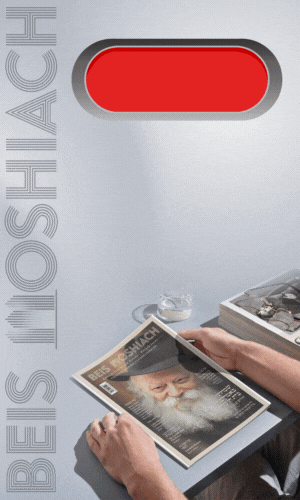“The Eyes Were Given Permission To See…”
3 million Americans suffer chronic visual impairments that cannot be corrected medically, surgically or with conventional eyeglasses. But now, a technology used in the Persian Gulf War has been transformed into a visual aid to help them see • By Prof. Shimon Silman, Beis Moshiach • Full Article
Prof. Shimon Silman, Beis Moshiach
I remember sitting in the waiting room of a dentist’s office in Minnesota early in 1991. Looking for something to read while I waited, I picked up a Time magazine and started reading an article on the Persian Gulf War in Iraq which had just begun. The article said that it was projected to be a high-technology war lasting many months. Well, they were half right. The war ended on Purim that year, lasting only about 6 weeks. But it was certainly high-technology making use of the newest military technology including stealth bombers, cruise missiles, so-called “smart” bombs with laser-guidance systems and infrared night-bombing equipment.
A year later the “Swords into Plowshares” declaration was made at the UN, and military technology began to be transformed for peaceful uses.
Low Vision Enhancement Systems
Some three million Americans suffer chronic visual impairments known to ophthalmologists as “low vision,” which means that they are not totally blind but retain some degree of useful vision. These disabling impairments cannot be corrected medically, surgically or with conventional eyeglasses. But now, technology used in the Persian Gulf War has been transformed into a high technology visual aid to help these people see.
Pilots in the Persian Gulf War wore head-mounted units which displayed before their eyes the region on the ground containing their target. By merely focusing their eyes on the image of the target on the display before their eyes (called “eye-tracking”), then pressing a button, a missile would be shot at the target on the ground below.
This technology is the basis for the Low Vision Enhancement System (LVES), a video headset that offers people with low vision a view of their surroundings equivalent to the image on a five-foot television screen four feet distant from the viewer.
“LVES does not fix vision or restore vision. Instead, it alters images to make them easier for people to see with the vision they still have,” says Dr. Robert W. Massof, professor of ophthalmology at Johns Hopkins University and lead inventor. He and his colleagues at the Johns Hopkins University Wilmer Eye Institute collaborated with scientists at NASA’s Stennis Space Center on the project. (NASA itself was, of course, originally established with military objectives in mind.)
The device is designed to enhance and compensate for low vision in people whose eyesight with conventional eyeglasses is worse than 20/100 in their better eye, but better than 20/800. The system is used by people with a variety of low vision conditions, particularly those who have experienced loss of central vision, the part of vision normally used for reading. These patients may have macular degeneration associated with aging or diabetic retinopathy, in which diabetes causes swelling and leakage of fluid in the center of the retina, the macula. The system also has benefited people who have lost peripheral or side field vision, a problem associated with glaucoma, an increase of fluid pressure inside the eye that damages the retina and optic nerve, and people suffering from retinitis pigmentosa, a progressive degeneration of the retina that results in tunnel vision and extreme sensitivity to light. Persons with optic nerve disease and congenital damage to the retina also use the LVES successfully.
The lightweight headset, worn like goggles, is fitted with three miniature, black-and-white video cameras. Two of the cameras, one over each eye, provide a normal, 3-D view to observe what’s happening in their environment. A third, more complex camera is used for seeing facial features, fine details of objects, distant objects, or for close-up, detailed work and reading. A control unit allows the user to select and control the cameras, and to adjust contrast and image polarity to suit the user’s needs. The cameras feed the images to a computer that corrects for the particular vision problem of the user, and then sends the images to the video display in the goggles.
Controls built into a battery pack worn on the belt let the wearer adjust contrast and magnify images from 1.5 to 10 times. The unit automatically compensates for changes in lighting to reduce glare in bright light. In addition to displaying images from the built-in video cameras, a cable connection lets the LVES become a personal large screen display for input from televisions, videocassette recorders or computers.
In 1992, the prototype LVES was unveiled and publicly demonstrated. Eleven centers of the Department of Veteran Affairs provided the patient population and conducted clinical trials of the system, on the basis of which final design modifications were incorporated into the headset. Visionics Corporation of Minnesota was founded in July 1992 to manufacture and market LVES
As Visionics describes it: “The LVES does for video images what headphones do for sound. It presents the enlarged image of a video screen to each eye in a way that creates a sense of being immersed in a video scene.”
Brad Blankenship, president of Visionics, comments:
“Our engineers are experienced in building vision systems for the military, like the helmet mounted displays that helicopter pilots used during Operation Desert Storm. To use such high technology for this uniquely peaceful, beneficial application is very satisfying.”
Indeed—Swords Into Plowshares!
LVES became commercially available in 1994 and hundreds of units were sold and used successfully, but after a while it became less popular and was available only through the Wilmer Eye Institute [Some people with low vision were first made aware of the existence of LVES by reading the reports of the RYAL Institute on it in the 1990s. They contacted us and we directed them to medical offices in the New York area that provide it.]
The Second Generation Project
In 2015 Dr. Massof was awarded a grant for his “Next Generation of Low Vision Enhancement” project which he described as follows:
The goal of the project is to produce a binocular-style head-mounted display system that enhances a user’s low vision with programmable real-time image processing that has been optimized for the individual patient. It is intended for full-time wear and would be the first versatile low-vision device that uses eye-tracking to enhance vision in the region of interest. It has a large binocular field of view so it can be used while walking. It automatically controls illumination, thereby eliminating glare. And with an auto-focus feature, it can be used at any viewing distance.
I emphasized the phrase “that uses eye-tracking to enhance vision in the region of interest” because, as Dr. Frank Werblin, another researcher in low vision enhancement, said, “Traditional treatments use magnification, but they magnify everything. Most people with low vision experience blurriness only in the center of their eye and don’t need the whole-eye magnification that existing treatments offer. If you wear a telescope, then you lose peripheral vision. So our challenge was to find a way for people to see the world in context, but to create a kind of telescope in the middle of that view.”
Simply put, they needed the surrounding field of view to look normal and only the place that the eyes were focused on would be magnified. As the eyes would move across the field of view, the area of magnification (they called it the “bubble”) would have to move also—the eye-tracking. A system without eye-tracking would still have head-tracking: To focus on another point in the field of vision, one would have to turn his head, not just shift his eyes.
Dr. Werblin has been a neurobiology professor at the University of California in Berkeley for 40 years, specializing in retina research. He was an electrical engineer by training and actually created a set of circuits that behave exactly like the retina does. He was able to use that to process visual images in real time. Dr. Massof describes him as “a superstar in neurophysiology and vision.”
Professor Werblin was not initially involved in low-vision research. As he explains, “I was interested in higher level visual neuroscience—trying to understand how the neurons in the retina interact to generate the visual message…I became interested in providing some aid for the low-vision community.” He formed a company called Visionize and began investigating the state of the art of low-vision technology. When he discovered Dr. Massof’s work on LVES, he called up Massof and said, “I think we need to talk…” and they ended up collaborating on the project.
First, they needed people who were experts on head-mounted displays so they contacted Sensics, a developer and manufacturer of high performance virtual reality products. Dr. Massof explains:
“To develop eye-tracking capabilities, we eventually started using one of Sensics’ head-mounted displays. They’re off-the-shelf head-mounted displays that the military uses to train tank drivers and other personnel. We built the eye-tracking into that, which it didn’t have previously.”
More military technology transformed…more Swords into Plowshares!
Finally, what brought it all together was that another company, Oculus, entered into a deal with Samsung to build a headset using a Samsung smartphone. (This technology was initially developed for the gaming community. Yes…for video games.) “What that means,” Dr. Massof says, “is that it’s now possible to go to Best Buy, buy the Oculus virtual reality headset and the Samsung phone, plug them in, and have a complete system. The good thing about the Samsung phone is that it uses Android software, which Sensics also uses. So Sensics developed all of the processing we needed to run it on a Samsung phone.”
What about the cost? Dr. Werblin says that their goal is to make the technology available to as many people in the low-vision community as possible. He explains, “You buy a [Samsung] smart phone for a couple of hundred dollars. You buy this Oculus device for a couple of hundred dollars. You install the app on the phone and you have a fully functional low-vision device for under $500.” Other, inferior devices currently available, he says, cost $15,000!
If the Eyes Were Given Permission…
What is the takeaway from all this? Well, first of all, the knowledge that the Swords into Plowshares program continues unabated. It’s a Messianic prophecy; it’s part of the Geulah. Just like every other aspect of the Geulah, once it starts it just continues until the Geulah is complete. Or, in the now famous words of a scientist of the Chinese Academy of Engineering Physics, “The transformation of military technology to peaceful uses is the trend of history.”
Secondly, we are all part of the low-vision community on some level. There are things right before our eyes that we simply don’t see, don’t notice. As I was writing this article I suddenly wanted my chocolate bar. Yes, I knew where my pipe was but I couldn’t find my chocolate bar. I went to where I had put my jacket and looked in all my pockets. Not there. I looked here, I looked there…everywhere. It was nowhere to be found. I finally gave up and went back to my desk and sat down to continue writing. And there it was right in front of me.
We look at a piece of paper and what do we see? A blank piece of paper. We see nothing of what’s going on inside that piece of paper—the molecules, the atoms and the subatomic particles all doing their jobs. We look at a person and see him smiling or looking serious etc. But we don’t know what he’s thinking or what’s motivating him. “No one knows what’s in his friend’s heart,” Chazal say.
We look at world events and usually have some superficial interpretation for them, usually based on our education or the narrative that the media (hopefully Fox News and not CNN) is presenting—all too often a Golus mentality.
What is the solution? Simple. For each of these cases we need a Low-Vision Enhancement System. For the piece of paper, an electron microscope may be all we need to “see” the electrons, as well as other similar equipment. To know what our friend is thinking, what his motivation is, well…the Alter Rebbe tells us straight out that it’s none of our business: “This is the job (מלאכת) of heaven and not the business of people.” We are instructed to look for the good in our fellow Jew because deep down it’s always there.
For world events the LVES is to learn seforim on Moshiach and Geulah—plain and simple. Early on, the Rebbe MHM gave this instruction—to learn seforim on Moshiach and Geulah so that we will know what’s going on in the world in this new era, the Era of Moshiach, and not look at the world with the old Golus mentality. So, for example, if someone learns the sicha of Parshas Mishpatim, 5752, he will realize that Swords into Plowshares is the trend of history and he will look at world events through that lens.
And then there are the miracles that Hashem is doing for us all the time that we are not aware of: “The one who experiences the miracle does not realize that a miracle has occurred.” So we ask Hashem to open our eyes to see these miracles—and He will. But in the meantime we make sure to thank Him for them every day in our davening: “We thank You…for Your miracles that are with us every day…”
But even all this is only low-vision enhancement. We still won’t have perfect vision. We still won’t see the truth. The Alter Rebbe says in Tanya that “if the eye were given permission to see and to comprehend the spiritual life in every creation which comes to it continuously from the mouth of Hashem, the material aspects of the object would not be visible to our eyes at all.”
But that’s OK because right now that’s not our business. We’ll see it all when the Geulah is complete. Right now our job is to continue to work on removing what’s left of the concealment of the G-dliness in the world and to bring about the “revelation of the glory of G-d” and the complete revelation of the Rebbe Melech HaMoshiach—immediately!
*
The magazine can be obtained in stores around Crown Heights. To purchase a subscription, please go to: bmoshiach.org
183
Join ChabadInfo's News Roundup and alerts for the HOTTEST Chabad news and updates!










































